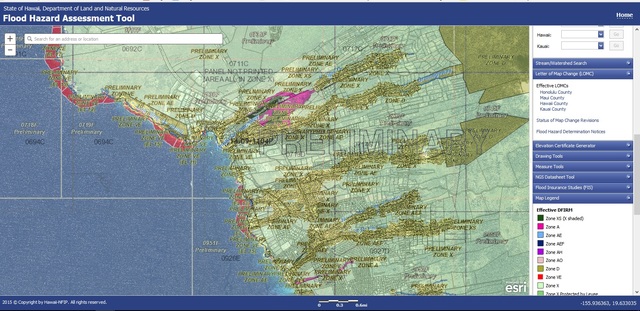Changes to the flood map 10 years in the making coincided with rain so bad drivers were asked to stay off the road. ADVERTISING Changes to the flood map 10 years in the making coincided with rain so bad drivers
Changes to the flood map 10 years in the making coincided with rain so bad drivers were asked to stay off the road.
The meeting was on the new flood plain maps being prepared by the Federal Emergency Management Agency at the West Hawaii Civic Center Tuesday night.
The presentation was led by Eric Simmons, senior engineer for the mitigation division.
He said the maps were made with the “best available data,” boosted by new technologies. One part is the replacement of the old paper maps with new digital ones.
It included the use of aircraft equipped with LIDAR, a device using a laser to pick a point and then measuring the reflection.
Residents questioned the accuracy of relying on such information.
The LIDAR was only one of several tools used, including the occasional ground crew, Simmons said.
The calculations are made on the “one percent” model, as the flood is assumed to have a one percent chance of happening each year. This leads to its common term as a 100-year flood.
Any property within a 100-year flood area is required to have flood insurance and operate on a floodplain management regulation.
That includes zoning changes or construction permitting, which was brought up several times during the presentations. Simmons directed those questions to county officials, including Department of Public Works director Warren Lee.
Changes to the maps in the Kona region were to watercourses in Captain Cook, South Kona, Alenaio Stream, Holualoa and Waiaha.
Areas expanded or contracted based on better information, construction, fires or other reasons, said the researchers. The changes can be seen at https://gis.hawaiinfip.org/FHAT/ by using the “Preliminary DFIRM” option. Physical maps are available at the department of public works at the civic center.
There was a mixture of increase and decrease of the size of the zones at the watercourses. Other areas remained the same size, but saw a worsening or improving threat evaluation.
“These maps are risk mitigation tools,” said Olivia Humilde, mitigation outreach specialist with FEMA. They help direct development out of areas of danger, she said, and guide safer decision making.
Some of the people present were concerned about how the flood areas were laying, questioning the reasoning behind it.
Appeals are possible, so long as they show the flood determinations are scientifically or technically incorrect, FEMA wrote.
People can also comment more generally.
The 30-day comment period began on Monday. People can submit their comments directly to eric.simmons@dhs.gov.
The group of about 30 attendees was a mix of real estate agents, attorneys, appraisers and homeowners from the area.
Also present were people from the Department of Land and Natural Resources to help with issues related to the flood insurance program.
The program is a collaboration between the federal government and private lenders.
“It’s the lender’s preogative to require insurance,” said Simmons. He had been asked about rules related to zones crossing property lines.
One concern for multiple property owners was the status of their letters of map change. These show that a home may be in a flood area, but is high enough to be safe from the waters. Humilde said the improved technology allows for better mapping, and most of those letters will be incorporated into the new map.
A few of the letters for properties in special situations, such as being the only home above the flood area in a region of homes in danger of a flood, will need to be reissued the day after the map is finalized, she said.
The decision to have this review was a collaborative effort of the local residents, county and FEMA, said Humilde.



